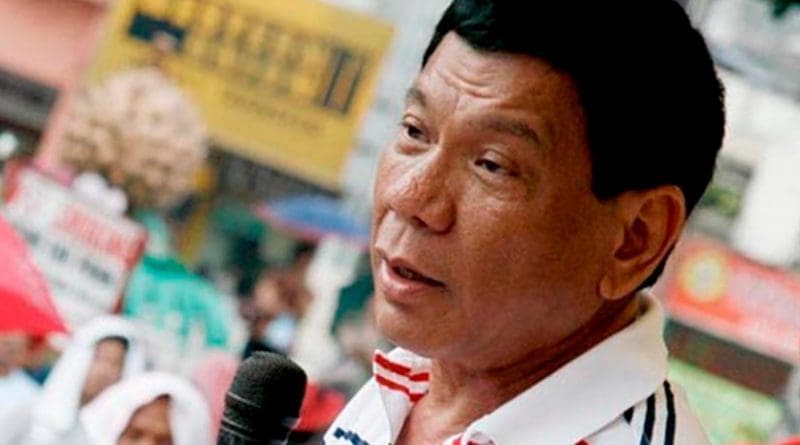Manila Embraces The United States Despite Duterte’s Neglect – Analysis
By Julius Cesar Trajano*
Philippine National Defense Secretary Delfin Lorenzana criticised the ‘swarm’ of 220 militarised Chinese fishing vessels around the Whitsun Reef in the South China Sea on 21 March. In his view, the act was a provocation within the Philippines’ Exclusive Economic Zone and on its continental shelf. It is legally recognised as such under international law and the 2016 South China Sea Arbitration.
Whitsun Reef is part of the Union Banks — a submerged atoll at the centre of the Spratly Islands that is claimed by China, the Philippines and Vietnam. The latest incident raises concerns that ‘swarms’ of militarised Chinese vessels might be a prelude to Beijing taking de facto control over the maritime feature, as it did to Mischief Reef in 1995 and Scarborough Shoal in 2012.
The Philippine Foreign Affairs Department has issued almost daily diplomatic protests to the Chinese embassy, demanding that Beijing promptly withdraw its maritime assets across all Philippine-claimed features in the Spratly Islands. It even summoned the Chinese envoy to Manila on 13 April, the first time since the start of the Duterte presidency in 2016.
This recent development demonstrates how Philippine President Rodrigo Duterte’s strategy of non-confrontation and closeness with China at the expense of its security alliance with the United States has not changed Chinese behaviour in the South China Sea. This is unsurprising since China’s aggressiveness, militarisation and overfishing — often at the expense of Filipino fishermen — formed the basis of China’s maritime strategy well before Duterte took up the presidency.
Leading into the 2022 national elections, Manila will likely return to a more popular, confrontational stance towards Beijing. The race to replace Duterte will feature anti-China rhetoric from potential presidential candidates including his closest political allies and cabinet members. Duterte employed the same rhetoric to great effect in 2016.
In the context of growing popular and political opposition to China, one solid option for the Philippines is to re-embrace its security alliance with the United States. Joint allied patrols, military exercises and the deployment of US military assets to the Philippines would form a strong response to Chinese maritime activity and militias.
Since the issue erupted, officials on both sides have proposed several measures to deepen defence cooperation between the United States and the Philippines, including by enhancing situational awareness of threats in the South China Sea.
US officials reiterated that the Mutual Defence Treaty (MDT) would be invoked if China attacked Philippine public ships, aircraft or troops in the South China Sea. The Balikatan military exercises, the most prominent annual military exercises between Washington and Manila, were also resumed on 12 April.
Joint efforts to enhance the MDT and the 1999 Visiting Forces Agreement (VFA), an agreement allowing Washington to retain jurisdiction over US troops stationed in the Philippines, should be seen as a response to the failure of Duterte’s appeasement strategy.
Philippine Foreign Affairs Secretary Teddy Locsin Jr wants to extend the coverage of the MDT beyond attacks on public and military vessels to include civilian vessels, giving the Philippines an additional reason to invoke it. Other Filipino security experts recommend that the Philippines should reconsider joint maritime patrols with the United States in the South China Sea as a symbol of their ‘iron-clad’ alliance.
Despite Duterte’s anti-US rhetoric, there are several reasons why the Philippines remains a close ally of the United States.
First, the Philippine defence establishment maintains a close partnership with the US military given their long history of joint training and professional exchanges. The defence establishment has subtly moved to postpone the termination of the VFA. After Duterte threatened to abrogate the VFA with the United States, his own Secretary of National Defense Delfin Lorenzana announced the military was largely supportive of the agreement.
Second, while Manila’s military modernisation steadily progresses, the Philippines military benefits from regular training and capacity building exercises with US forces. Washington has delivered US$765 million worth of military aid to the Philippines since 2015, making the country the largest recipient of US military assistance in the Indo-Pacific region.
Third, 60 per cent of Filipinos see their former coloniser, the United States, as the country’s most trustworthy foreign partner, while China is among the least trusted. The failure of the Duterte presidency in managing the COVID-19 pandemic — with its over-reliance on China’s Sinovac vaccine and ignoring of China’s behaviour in the South China Sea — further contributes to growing anti-China sentiment.
Fourth, the alliance goes beyond high-level security talks and military exercises. There is strong grassroots support in the Philippines for addressing non-traditional security threats like disasters, marine environmental threats and climate change.
With popular support for Washington’s place in Philippine security policy, Duterte may come under pressure to drop his defeatist strategy towards China, including his refusal to condemn the deployment of Chinese maritime militias in the South China Sea. Otherwise, it will be for the Filipino electorate to choose a successor who will prioritise a change tack in 2022.
*About the author: Julius Cesar Trajano is a Research Fellow in the Centre for Non-Traditional Security Studies at the S Rajaratnam School of International Studies, Nanyang Technological University (NTU), Singapore.
Source: This article was published by East Asia Forum

